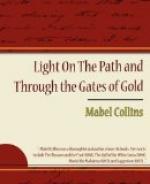“To the one who has lifted the golden latch the spring of sweet waters, the fountain itself whence all softness arises, is opened and becomes part of his heritage. But before this can be reached a heavy weight has to be lifted from the heart, an iron bar which holds it down and prevents it from arising in its strength.”
The author here wishes to show that there is sweetness and light in occultism, and not merely a wide dry level of dreadful Karma, such as some Theosophists are prone to dwell on. And this sweetness and light may be reached when we discover the iron bar and raising it shall permit the heart to be free. This iron bar is what the Hindus call “the knot of the heart”! In their scriptures they talk of unloosing this knot, and say that when that is accomplished freedom is near. But what is the iron bar and the knot? is the question we must answer. It is the astringent power of self—of egotism—of the idea of separateness. This idea has many strongholds. It holds its most secret court and deepest counsels near the far removed depths and centre of the heart. But it manifests itself first, in that place which is nearest to our ignorant perceptions, where we see it first after beginning the search. When we assault and conquer it there it disappears. It has only retreated to the next row of outworks where for a time it appears not to our sight, and we imagine it killed, while it is laughing at our imaginary conquests and security. Soon again we find it and conquer again, only to have it again retreat. So we must follow it up if we wish to grasp it at last in its final stand just near the “kernel of the heart.” There it has become “an iron bar that holds down the heart,” and there only can the fight be really won. That disciple is fortunate who is able to sink past all the pretended outer citadels and seize at once this personal devil who holds the bar of iron, and there wage the battle. If won there, it is easy to return to the outermost places and take them by capitulation. This is very difficult, for many reasons. It is not a mere juggle of words to speak of this trial. It is a living tangible thing that can be met by any real student. The great difficulty of rushing at once to the centre lies in the unimaginable terrors which assault the soul on its short journey there. This being so it is better to begin the battle on the outside in just the way pointed out in this book and Light on the Path, by testing experience and learning from it.
In the lines quoted the author attempts to direct the eyes of a very materialistic age to the fact which is an accepted one by all true students of occultism, that the true heart of a man—which is visibly represented by the muscular heart—is the focus point for spirit, for knowledge, for power; and that from that point the converged rays begin to spread out fan-like, until they embrace the Universe. So it is the Gate. And it is just at that neutral spot of concentration that the pillars and the doors are fixed. It is beyond it that the glorious golden light burns, and throws up a “burnished glow.” We find in this the same teachings as in the Upanishads. The latter speaks of “the ether which is within the heart,” and also says that we must pass across that ether.




